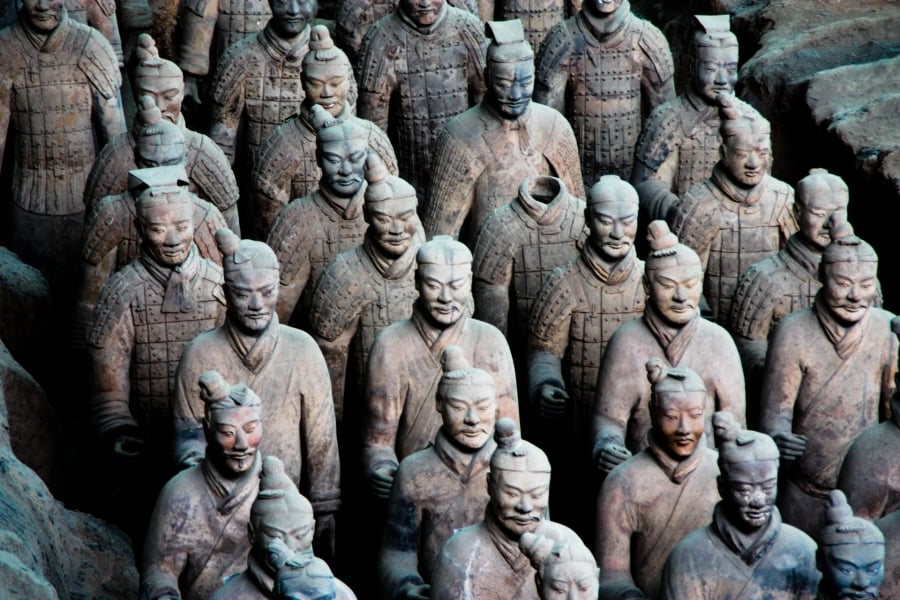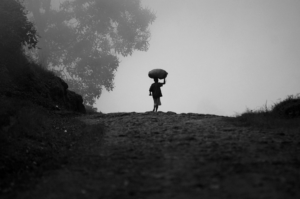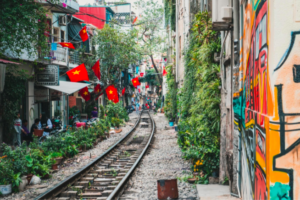48 hours to learn 3,000 years of Chinese history
In a country with more than a billion people, it’s hard to stand out. Even the cities clash for attention—Beijing with its stretch of the Great Wall, Shanghai’s East meets West cosmopolitan chic, Guilin’s stunning limestone scenery. But Xi’an, is like nowhere else in China. While most major cities have a single character abbreviation, Xi’an demands two. In ancient script, the first symbol is of a bird on a nest, signifying “west,” the direction of the sun at the end of the day when birds come home to roost. The second is of a frolicking girl, almost Disney-like in profile, with a graceful roof above her head, meaning “security” or “peace.” Off and on for almost a thousand years, the verdant flood plain of Xi’an, surrounded by eight rivers as well as jade and gold mines, was the peaceful western capital for an astonishing 13 dynasties and 62 emperors.
But it’s just one in particular who has brought me here—Qin Shi Huang, the first emperor to gather warring kingdoms into a unified China in 221 BCE. Failing to find the elixir of immortality, the emperor had to settle on creating a mausoleum filled with palaces and towers, treasures and rivers of mercury, to rule in death as he did in life. To guard such opulence required an army that could survive into the afterlife, a garrison of 6-feet-tall terracotta soldiers. But like a bad Mummy movie, to see the army of the dead, I must first brave the army of the living.

I have the misfortune of traveling during “Golden Week” where seemingly all of China’s 1.3 billion people are performing a mass migration often described as a “mountain of people, sea of people.” I later read that 415 million people visited tourist attractions across the country in just the first four days of the week-long holiday. Today, it feels like we’re all headed to Lintong, the site of the terracotta warriors 27 miles east of Xi’an. As traffic crawls, I notice the many streetside vendors selling baskets of neatly arranged persimmons and plump pomegranates bursting with bright red seeds, a symbol of large, happy families. Inside Pit 1, the largest of three excavation sites, there are large families, too, but they are anything but happy. Even though the pit is almost the size of three football fields, it’s filled to overflowing, and I can’t help but think that Qin Shi Huang’s 8,000 or so terracotta soldiers wouldn’t have stood stand a chance against the estimated 100,000 visitors craning and straining to get a glimpse of the clay army. To get to the one ideal vantage point in the front where all the soldiers are facing forward requires navigating a tightly pressed, human Great Wall of bodies, six or seven deep, all vying for the perfect terracotta selfie. Finally jostling my way to the front in my own sweaty battle fought with elbows and hip checks, I come face to face with rows upon glorious rows of men and horses, immortalized in battle-ready formation. As I scan the vast army of 2,000 or so soldiers, with another 4,000 as yet unearthed, I try to pick out the hairstyles and uniforms that differentiate the infantry, cavalry, charioteers, officers and generals.

Further down the pit, the painfully slow work of excavation and restoration has been taking place ever since farmers serendipitously uncovered the site in 1974 while digging a well. Archaeologists discovered that when built, the soldiers were lined up in corridors 16 feet below ground level, with thick earthen partition walls acting as supports for a roof of heavy wooden rafters. Fiber mats and more earth were piled on, completely concealing the army from above where they would remain buried and forgotten for more than 2,000 years. Over time, the wooden roofs gave way, crushing the soldiers below into hundreds of thousands of shards, turning the army into the world’s greatest 3D jigsaw puzzle. On a slab in the center of the pit, fragments of one soldier are laid out, missing a torso, in a disconcerting version of CSI: Xi’an. Other soldiers have mostly been reassembled, temporarily held together with straps and plastic wrap, eerily lifelike features gazing out from cracked masks patiently waiting to be made whole again.

While remarkable for their sheer multitude, what’s even more fascinating is that each statue is unique in shape, size and facial features. There are the generals with big bellies bloated from copious amounts of pre-battle beer, charioteers with hands outstretched holding imaginary reins, and archers with bows semi-drawn. A single, exquisite kneeling archer is on display in Pit 2, one of the rare warriors to have been unearthed completely intact, down to wrinkles on his battle robe and stitches in the soles of his shoes. But it’s the faces that captivate. There’s the baby-faced infantryman, eyes open wide, and the battle-hardened officer, expressionless as if war is both friend and foe. A general with arched eyebrows to go with a pencil mustache shoots a death glare as intimidating now as it was 2,000 years ago. Recent studies focusing on the warriors’ ears, unique as fingerprints, seem to confirm what people have thought for decades, that the statues were based on actual individuals instead of simply mass produced. That level of detail may explain why it took 700,000 workers 30 years to build the army.

Past To The Future
Wanting to know more about the faces that have played a role in this city’s long narrative, I head to the Shaanxi History Museum, home to nearly 400,000 artifacts that tell the story of this province from prehistoric times down through its succession of dynasties. In its dramatically lit galleries, I see many faces, some human, some not, like the legendary taotie, an animal that voraciously ate everything until one day it ate itself. It’s emblazoned on the side of a metal cauldron used for boiling meat, a reminder against gluttony. Then there’s the mythical pixiu, an animal that devours gold and silver but has no anus, a favored mascot amongst businessmen for attracting wealth. But it’s the snarling face of a 13-foot-high stone lion that resonates most with me. While most Chinese lions are pictured lying down or squatting, this one is running on all fours, mouth agape, teeth bared. A replica from the Shunling Mausoleum, the ancient lion symbolizes China rushing out to meet the world, largely facilitated by the fabled Silk Road. In the third century BCE, Xi’an became the eastern terminus of the trade route, offering up silk so fine that a woman could wear five layers of it and still see a birthmark on her arm. But perhaps even more important than silk, tea and porcelain, the road carried with it new ideas and cultures.

In the 7th century, a monk named Xuanzang traveled 10,000 miles along the Silk Road, crossing mountains and deserts to India to bring original Buddhist writings back to Xi’an. To learn more about this monk on a mission, I head to the nearby Big Wild Goose Pagoda and come face to round face with his large metal statue in the square. Rebuilt by Wu Zetian, China’s only female emperor who also ruled from Xi’an, the very plain seven-story tower was originally a library housing the delicate slices of wood inscribed in ancient Pali which Xuanzang spent the rest of his life translating. I wander the rooms, some filled with giant murals elaborately carved out of exquisite boxwood and priceless jade telling the life story of the Buddha. In the courtyard, children play hide and seek amongst centuries-old stelae, while students about to take the national exam rub their fingers for good luck against a 1,000-year-old tablet inscribed with the names of ancient scholars.

The Silk Road also brought foreigners to Xi’an—Iranians importing carpets, Uzbekistanis dealing in glassware, Indians bearing spices. Some continued on, while others, including Arab and Persian traders, settled down, intermarrying and integrating into Chinese society. I walk over to the 70,000-strong Muslim enclave behind the city’s Drum Tower, the heart of the Hui or Chinese Muslim area. Thanks to their loyalty to the Tang emperors, the Hui were given this choice neighborhood in the middle of the walled city. While in almost all respects Chinese, without a particular dialect of their own, the Hui can sometimes be identified by their dress—men wearing delicate white caps and women with head scarves. I can also see it in their faces—a boy with round eyes flashing flecks of light brown, a girl with slightly curly hair tucked under a glittery pink scarf. I walk down “Muslim Street” and take in the cacophony of sounds—giant wooden hammers pounding candy, hawkers touting beautifully patterned flatbreads, and the thwap of hand-pulled noodles as they hit the oiled metal table. This area is known for its incredible street food, a delightful mix of Chinese cooking styles and Middle Eastern spices. I pick my way through the maze of stalls and spot sure signs of a good eatery—hanging animal carcasses stripped clean to the bone and a bucket full of discarded red willow skewers. I sit down for some chuan’r or grilled mutton flavored with cumin and chili. In a waft of smoke, the cook makes several heavy-handed passes of spices, like a farmer sowing seed, producing some of the most flavorsome, tender mutton I’ve ever had. Satiated for the moment, I make my way through a narrow bazaar to the Great Mosque of Xi’an. Built in 742 AD, it’s said to be China’s oldest and largest. But instead of spires and minarets, the mosque is almost entirely Chinese in its architecture. I stroll through the quiet courtyards, past the Prayer Hall and the “God is One” inscription in Arabic, one of the few obvious indications that I am indeed in a mosque. The rain lets up just enough for a bearded worshiper to lower his umbrella and flash me a huge smile of welcome.

By the time I make it to the city wall, the light rain has turned into a steady drizzle, but that hasn’t deterred tourists and locals alike from climbing the 40-foot-high fortification encircling the old city. Built in the 14th century and surrounded by a moat, it’s one of the oldest and best preserved city walls in all of China. The 9-mile-long, 40-foot-wide walkway atop the wall has welcomed everyone from a jogging Mark Zuckerberg to a dancing Michelle Obama. Today, though, it’s just we, the people, swathed in tattered disposable raincoats, sheltered under colorful umbrellas, or peddling wobbly tandem bikes. I wander past the ramparts, spaced almost 400 feet apart, just within arrow range of each other. I take in the scenery on both sides of the wall and see the two faces of Xi’an—the beautiful Bell Tower and the low houses with baked clay roofs of the ancient city on one side, and the skyscrapers of modern Xi’an on the other. Not content to simply look back, city officials have plans to move Xi’an ever forward. By 2020, it is hoped that at least half of Xi’an’s 10 million residents will be able to read 500 or more traditional Chinese characters, know 900 English sentences and be able to guide visitors around the city’s landmarks in English. By then, the province also aims to add more than 2,000 miles to its railway, making Xi’an the center of a “one-day traffic circle” covering half of China.

In a city where residents interact with history on a daily basis—commuting through the gates of a 700-year-old wall or doing Tai Chi next to a thousand-year-old pagoda—it’s clear that Xi’an isn’t done making history, facing forward as much as looking back.
My guides from City Discovery were invaluable to researching this article, sharing their passion and insight into Xi’an’s long and fascinating history. While you can see the terracotta warriors by public transport, having dedicated transportation, especially during the holiday crush, was a godsend. History can very easily become dry and museums overwhelming, but my guides shared gems of information and pointed out details that I would certainly have missed on my own. City Discovery provides sightseeing tours, travel experiences and ground transportation in over 700 destinations worldwide.
TEXT AND IMAGES BY JAMES PHAM






